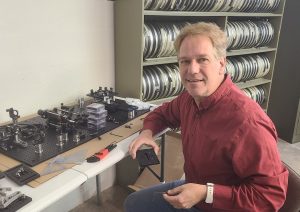“Imagine if you put an orange in New York City and could view it from Anderson Mesa.”
This work is possible because van Belle uses the biggest optical telescopes in the world, known as Very Large Arrays, or VLAs. But, unlike the giant radio telescope array in Socorro, New Mexico, the instruments van Belle uses are optical VLAs. Instead of using radio waves, they detect incoming visible light, combining it using a clever technical trick called “interferometry.”
Van Belle has worked on every major optical interferometer on the planet, including the Keck Interferometer in Hawaii. In fact, on his first job after grad school, he was tasked with linking those two Keck telescopes. “I had to align small mirrors that direct light from the main mirrors to the detector, to within fractions of an inch, by hand. It involved hanging from girders on the giant structure as it tracked the sky. I was swung around as if I were on a high-priced amusement park ride about 50 feet off the ground,” he said.
Until recently, van Belle has worked with an instrument much closer to home. Those who have driven on Lake Mary Road south of Flagstaff may have seen the signpost to “NPOI.” This Northern Arizona VLA is the Navy Precision Optical Interferometer (NPOI), on Anderson Mesa. It became operational in 2011, with major upgrades initiated by Lowell Observatory in 2017.
It might not look like much from the ground, but viewed from above, NPOI is shaped like a giant “Y” 450 yards across. Each arm is 250 yards – that’s around two-and-a-half football fields long. Light from space is caught with six small telescopes placed along the arms of the Y. That light travels down the connecting pipes with the air sucked out of them to minimize distortions.
“There are two Olympic-sized swimming pools-worth of vacuum inside this system,” said van Belle. The individual telescopes must be linked with extreme precision, he explained, using mirrors on trolleys, which run up and down on rails, aligned 1,000 times every second, to within 10 nanometers – around one-thousandth of the width of a human hair.
When aligned correctly, NPOI can show exquisitely small things in space. “Imagine if you put an orange in New York City and could view it from Anderson Mesa. NPOI’s resolution would let you read the ‘Sunkist’ label on that orange,” he explained.
Van Belle has used this extraordinary technology in studies of exoplanets – including mapping details of the stars around which exoplanets are known to orbit.
Now, van Belle and colleagues want to put a VLA on the moon. “We’ve proposed a project to NASA under their funding line for small missions called Astrophysics Pioneers – and are still waiting to hear whether it will be approved,” said van Belle. The components can be quite small because, with no atmosphere on the moon, even a modest lunar telescope can easily beat the biggest Earth-based ones.
Called “MoonLITE” it would be deployed by one of the planned robot lander missions, which NASA is starting to send to the moon this year. The team has already been funded by NASA to study the possibility of deploying a much larger lunar VLA using one of NASA’s planned Artemis crewed missions.
“There’s been very little astronomy done from the surface of the moon up until now,” said van Belle. “This would make the lunar surface into a major astronomical facility.”
This work is an example of how Lowell Observatory’s significant historic research is continuing on in active study. “Our visitors are always excited to talk with professional astronomers, something Lowell is uniquely positioned to offer to guests,” said Observatory Director Jeff Hall. And visitors will be able to enjoy an enhanced learning experience later this year, when the new Astronomy Discovery Center opens. Festivities are being planned for Nov. 8-16. FBN
By Diane Hope, FBN
Photo courtesy of Gerard van Belle: Gerard van Belle working on some of the smaller NPOI hardware.





